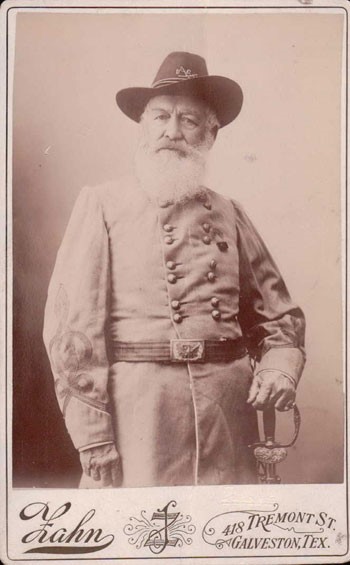
Brigadier General Thomas N. Waul modeled his Confederate uniform shortly before his retirement from law practice in Galveston in 1893. He and his family moved to Cherry Hill, east of Greenville where he began a new career with his successful orchards at age ninety.
Two years ago, I wrote about Hunt County’s only Confederate Brigadier General who arrived here when he was ninety years old. Since that time, I have acquired more information about General Waul and his Cherry Hill farm.
Waul was born in Sumter District of South Carolina. He was educated at South Carolina College before moving to Vicksburg to study law. Waul was admitted to the bar in 1835, two years before marrying America Simmons from Georgia. Two children were born to the couple, but neither outlived their parents.
By 1850 Mr. and Mrs. Waul and their entourage settled in Gonzales County, Texas, where Waul practiced law and owned a cotton plantation on the Guadalupe River. When the Civil War broke out, Waul was appointed to the Secession Convention of Texas. There he favored frontier defenses along with a constitutional right to import slaves from any location except Africa. His political interests are readily assumed.
Waul ran for the Confederate Senate in 1861 but was defeated. He returned to Brenham and recruited Waul’s Legion, a military unit composed of infantry, cavalry, and artillery components that he funded. It was the only true Texas Legion in the Confederate Army. With 2,000 men, Waul’s Legion was assigned to Arkansas and Louisiana. As the Union Army closed in on Vicksburg in the spring of 1863, Waul’s Legion guarded the city under siege. Finally, Vicksburg surrendered on July 4, 1863 and members of Waul’s Legion were taken prisoners of war. Later the legion was exchanged and reorganized in Houston to protect Texas. At the same time, Waul was promoted to Brigadier General on September 18, 1863. He and his men participated in the Red River Campaign in 1864 and in the Battle of Jenkins’ Ferry in Arkansas where General Waul was wounded.
He returned to the Gonzales plantation after the war where in 1866, Waul was elected to the Constitutional Convention. Later he relocated to Galveston where he practiced law until his eightieth birthday. At that time, he purchased farm land in Hunt County. Instead of planting cotton, Waul chose to create an orchard filled with fruit trees, an oddity in the area.
General Waul died on July 28, 1903 at the age of 90. His funeral was held in the 8th District Courtroom in the Hunt County Courthouse to accommodate the large crowds. His body was taken by train to Fort Worth where he is buried at Oaklawn Cemetery.
Recently I received a comment concerning the Waul house. This person remembered the house stood on the farm in the 1980s before someone bought the property, razed the structure, burned and buried the historic home and grounds. This informant noted that a small structure housing a detached library was actually moved to another location, but no clue where that was.
I have always wondered why General Waul relocated from Galveston to Greenville. Over the years I have heard rumors that Mrs. Waul was addicted to laudanum, today known as morphine. It seems that General Waul believed that leaving the city and moving to a rural home would cure his wife’s addiction. I don’t know if it did or not. She died the following year and is also buried in Fort Worth.
As to the historical marker, I have found it a couple of times. It is a granite stone similar to the one on the Hunt County Courthouse square. According to the Texas Historical Commission website, the monument was placed there in 1963 by the State of Texas. Others argue it was a 1936 monument, put there during the Texas Centennial. As in many historical conundrums, it’s just hard to find the truth.

Interesting new info Carol. Question: why was his body taken to Ft. Worth & not buried in Greenville or at the farm. I was asked this question today by a Ft. Worth resident & I told her if anyone would know; it would be you. Thanks.